Physical Address
304 North Cardinal St.
Dorchester Center, MA 02124
Skeletal growth around the elbow typically follows a characteristic development process. The elbow joint consists of the articulation of the distal humerus with the ulna (the ulnohumeral joint), the articulation of the distal humerus with the radial head (the radiocapitellar joint), and the proximal articulation of the radius and ulna (the proximal radioulnar joint). Skeletal maturation occurs from the primary ossification centers of the humerus, radius, and ulna, along with six secondary ossification centers. The sequence of ossification is the capitellum, proximal radius, medial epicondyle, trochlea, olecranon, and lateral epicondyle. When evaluating radiographs, variation can occur in the appearance of the ossification centers as distinct structures, and correlation with the contralateral extremity can help determine disease in questionable cases.
The ossification of the distal humerus extends to the condyles at birth and progresses through the secondary centers at various stages of development. The lateral condyle and capitellum appear in the second year of life. On a normal lateral radiograph of the elbow, the anterior humeral line intersects the anterior third of the capitellar ossific nucleus ( Fig. 134.1 ). This line is helpful in characterizing supracondylar fracture displacement in children. In the third year of life, the proximal radius ossific nucleus begins to ossify and is typically present in most children by age 4 years. Notches or clefts in the proximal radius metaphysis can sometimes be seen and are considered part of the normal variability of maturation. The medial epicondylar ossific nucleus begins to ossify between the ages of 5 and 6 years; however, fusion of the epiphysis does not occur until 15 to 16 years of age, placing this physis under stress during the throwing motion well into adolescence. The secondary ossification center of the olecranon process appears around age 7 to 9 years, whereas the trochlear ossific nucleus appears around age 9 to 10 years. The last center to appear is the lateral epicondyle, usually after age 10 years, and this center rapidly fuses to the lateral condyle shortly after being visible on radiographs. A thorough understanding of the stages of ossification and the appearance of the centers of ossification is critical for clinicians who treat pediatric elbow injuries ( Fig. 134.2 ). Any heterogeneous appearance to the nuclei or differences relative to the contralateral extremity in terms of size, density, position, or fragmentation could indicate abnormal development and may be the result of repetitive stress to the elbow, inducing vascular changes with resultant alterations in the maturation process. A failure to appreciate the normal progression of growth at the elbow could result in misdiagnosis, improper treatment, and progressive developmental abnormality.
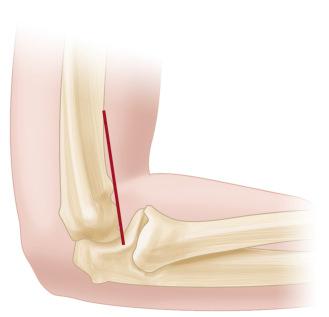
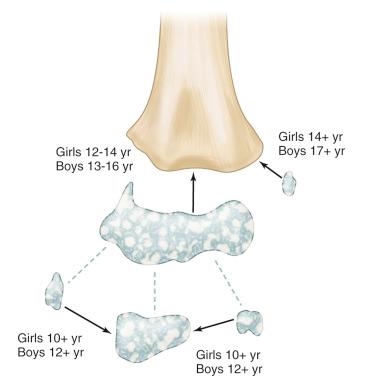
The osseous anatomy surrounding the elbow contributes significantly to stability of the elbow joint. Approximately 50% of elbow stability arises from the congruity of the ulnohumeral articulation. In serial olecranon excision studies, progressive loss of the proximal olecranon resulted in linear decreases in elbow stability at 0 and 90 degrees of elbow motion. The radial head provides 15% to 30% of valgus stability to the elbow joint, and may be more important in the throwing athlete for providing valgus stability through the midrange of motion. Studies evaluating the load transmission across the elbow joint have shown that forces of up to three times body weight can be seen, and forces that are generated during throwing may be even higher. Thus it is not surprising that a small deficiency in the elaborate stability-controlling mechanisms of the elbow may have a significant and cumulative effect on elbow function.
Whereas 50% of the stability of the elbow joint arises from the osseous anatomy, the remaining 50% is derived from the ligamentous and soft tissue attachments (e.g., the anterior capsule, the medial or ulnar collateral ligament [UCL], and the lateral radial collateral ligament). With regard to the muscular attachment sites around the elbow, laterally the common extensor origin is located at the lateral epicondyle and can be a common source of pathologic findings in persons who participate in racquet sport and repetitive motion activities. This source is perhaps more prominent in the adult population, with abnormalities classically located within the extensor carpi radialis brevis (lateral epicondylitis). Anteriorly, the brachialis and biceps serve as a powerful flexor and supinator of the elbow, respectively. Posteriorly, the triceps attachment on the proximal aspect of the olecranon serves as the main extensor to the elbow and can be injured in young athletes who have an eccentric contractile injury. Although injury or strain of these muscle groups can occur, this pathologic condition is less often seen in the pediatric population. Medially, the flexor and pronator attachment sites serve as powerful medial stabilizers to the elbow, particularly in the athlete whose sport entails throwing. Repetitive strain at this site can be seen in the throwing population or, alternatively, in golfers, in whom it can manifest as medial epicondylitis.
The UCL complex of the elbow is a broad ligament on the medial side of the elbow that provides restraint to valgus stress ( Fig. 134.3 ). The ligament consists of three portions: the anterior oblique bundle, the posterior oblique bundle, and the transverse ligament or intermediate bundle. The anterior oblique bundle is the main medial stabilizer to the elbow and arises from the medial epicondyle with an insertion to the medial aspect of the coronoid process. This ligament becomes more important during high-velocity throwing, when a large valgus force is placed on the medial elbow structures. Both the anterior and posterior bundles of the ligament provide stability during the full arc of motion, with the anterior band having a larger burden in extension and the posterior band having a more important role in flexion. The lateral collateral ligament provides varus stability to the elbow, and in recent years its role as a major contributor to posterolateral rotatory elbow stability has been more extensively studied. The lateral collateral (or radial collateral) ligament complex is composed of three main parts: the lateral UCL, the radial collateral ligament, and the accessory lateral collateral ligament ( Fig. 134.4 ). The radial collateral ligament courses from the lateral epicondyle to the annular ligament of the proximal radioulnar joint. The lateral UCL courses from the posterior lateral epicondyle, travels across the annular ligament, and attaches on the crista supinatoris of the ulna. This ligament is the primary restraint to posterolateral elbow stability. The accessory lateral collateral ligament originates from the inferior aspect of the annular ligament and attaches to the tubercle of the supinator. The lateral ligamentous complex is classically injured or disrupted during an elbow dislocation or iatrogenically during surgery around the posterolateral aspect of the elbow. These ligaments, combined with the anconeus muscle, form a lateral elbow complex that provides both dynamic and static restraint to elbow instability in both varus and rotation. The lateral ligament complex is rarely injured in children as a result of repetitive use or microtrauma; however, the medical literature includes case reports that describe reconstruction or repair of this complex when persistent instability exists. The diagnosis is often challenging because children may describe vague pain and soreness with certain activities, but without the characteristic instability that is the hallmark of this clinical entity in adults.
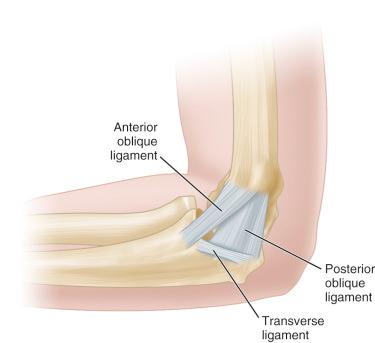
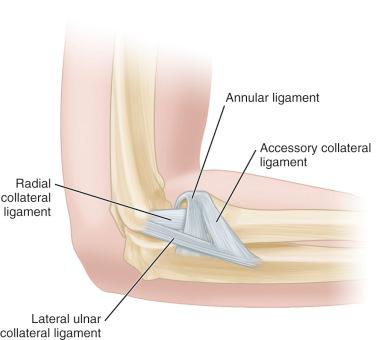
The throwing motion is common in many sports played by children and adolescents. Football, baseball, and overhead racquet sports such as tennis are the characteristic activities that demonstrate the biomechanics of the elbow during throwing and are most common in this age group. The pitching motion has been analyzed extensively in the adult and pediatric sports medicine literature. Repetitive valgus and distraction forces of the medial pediatric elbow have been observed during pitching and are thought to be the etiology in the development of medial UCL disease, medial epicondylitis, and epicondyle avulsions. The pitch has been divided into five stages :
Wind-up (ends when the ball leaves the nonthrowing hand; Fig. 134.5 )
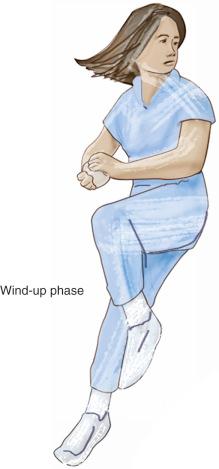
Cocking
Early cocking (shoulder abduction and rotation; ends when the forward foot hits the ground; Fig. 134.6 )
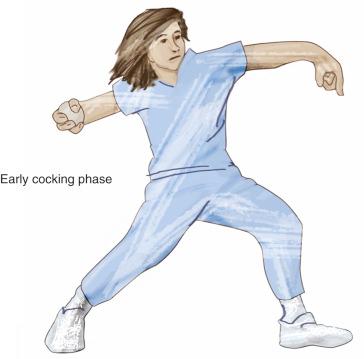
Late cocking (maximum shoulder external rotation is achieved; Fig. 134.7 )
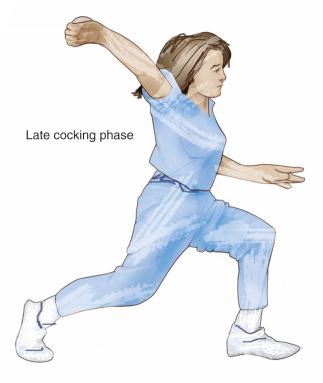
Acceleration (begins with internal rotation of the humerus and ends with ball release; Fig. 134.8 )
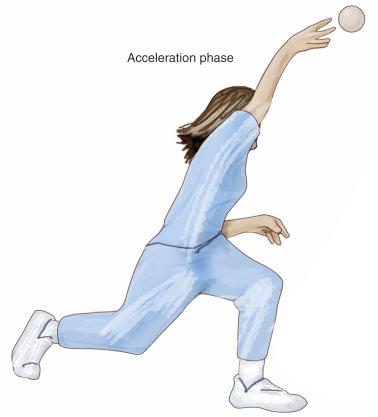
Deceleration (eccentric contraction of all muscles; center of gravity moves over plantar foot)
Follow-through (ends when all motion is complete; Fig. 134.9 )
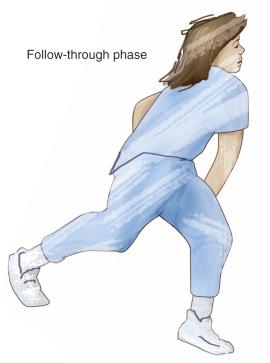
One of the fundamental concepts in understanding the throwing motion as it relates to pitching is the “kinetic chain.” The kinetic chain of throwing refers to the role that core and proximal musculature play into the development of force required for throwing. Proximal muscle activation results in postural adjustments that allow the body to balance the forces that are required for throwing. These muscle activations create force moments, which are a product of adjacent segment motion and position. The moments occur at proximal segments and are important for generating force delivered to distal motion segments, such as the elbow. One investigation demonstrated that younger pitchers may not produce as much force generation from their lower core segments, which may place larger demands on the upper extremities of youths who pitch and can ultimately cause pain and disability. Other investigations have documented that youths who pitch and adults who pitch have similar kinematics, while also demonstrating that youth pitchers who are deficient in their mechanics on key parameters are less efficient, place higher valgus loads across their elbows, and demonstrate higher humeral internal rotation torque. Lack of proximal force production may cause the elbow to be lower than the shoulder during the acceleration phase of throwing (as a result of a lack of elbow elevation and extension prior to shoulder rotation), which places increased tensile forces on the medial elbow. In the ideal motion, maximal elbow extension occurs prior to maximum shoulder rotation, which couples internal rotation of the shoulder to pronation about the elbow, preventing medial tensile or valgus overload. Teaching proper throwing mechanics in youth sports and limiting the opportunities of young throwers to “overuse” their arms is critical in preventing pathologic conditions of the elbow.
During the early and late cocking phases of throwing, significant distraction forces are placed on the medial elbow structures. This tensile force is transmitted to the medial UCL and medial epicondyle. In the pediatric population, the most vulnerable area of injury is the medial epicondylar physis, which can be avulsed with repetitive injury. In addition, the UCL can become stretched or incompetent, the flexor pronator mass can become strained, and the ulnar nerve can be stretched, resulting in neurologic symptoms. Whereas distraction forces are applied on the medial elbow, compressive forces are encountered on the lateral elbow structures during the early and late cocking phases. Sequelae of this repetitive compression of the radial head against the capitellum can result in growth disturbances, osteochondral fractures and loose bodies, and altered growth of the radial head.
During the acceleration phase of throwing, extreme pronation of the forearm results in a tension force on the lateral and posterolateral elbow structures. Lateral epicondylitis may result from repetitive overuse and strain of these muscles during this phase of throwing. During follow-through, hyperextension of the elbow places strain on the olecranon process and the anterior capsule. In late adolescence and into young adulthood, this stress can manifest as posteromedial elbow spurs, posterior/triceps spurs, and traction spurs of the coronoid process. Classic overload symptoms of the elbow result from forces generated during the throwing motion and are helpful in determining pathologic findings: tensile overload of the medial restraints, compression overload of the lateral elbow, shear forces of the posteromedial elbow, and extension overload of the lateral restraints.
Little leaguer's elbow, or medial apophysitis, is a broad term used to describe a spectrum of pathologic conditions that can occur in the young baseball player or thrower. Although we typically associate this spectrum of injury with baseball, a wide range of throwing or overhead sports, including javelin, tennis, and football, can present in a similar fashion. The throwing motion in the developing athlete is associated with significant force across the medial elbow. During the throwing motion, and particularly in the late cocking phase of throwing, a valgus traction force is created on the medial elbow structures (i.e., the medial epicondyle, epicondylar apophysis, and medial ligament complex), whereas a compressive force is transmitted to the lateral side of the elbow (radial head and capitellum). With repetitive stress to the medial elbow, microtrauma and potentially degeneration of these structures may occur. The subsequent tissue breakdown can cause the characteristic spectrum of disease: delayed or accelerated growth of the medial epicondyle, traction apophysitis and fragmentation of the medial epicondyle, medial epicondylitis, osteochondritis of the capitellum, hypertrophy of the ulna, osteochondral injury to the radial head, and olecranon apophysitis with delayed physeal closure.
Aside from overuse and repetitive stress to the medial elbow, young pitchers are believed to have altered mechanics relative to older athletes. Younger pitchers may initiate trunk rotation earlier in the throwing motion, which causes hyperangulation at the shoulder and increased torque along the longitudinal axis of the humerus during late cocking, predisposing them to elbow and shoulder pathology. Early trunk rotation occurs before the scapula and humerus are properly positioned in space. The resultant increase in horizontal abduction of the shoulder during stride results in excessive angulation of the shoulder throughout the cocking phase, which can predispose the athlete to anterior shoulder instability and an elevation in the horizontal adduction force applied to the humerus. When obtaining the history, a focus on the athlete's prior education regarding proper throwing mechanics, initiation of pitch counts with rest periods, and supervision for manifesting symptoms are all helpful in determining the prevention strategies that were in place for the athlete prior to the development of symptoms and can help guide treatment. Young athletes may not present in a typical fashion, and the symptoms may range from medial elbow pain and decreased throwing effectiveness to decreased throwing distance.
Obtaining a thorough history in pediatric and adolescent patients can often be challenging. The clinician must assess the overall affect of the child, as well as the importance of the sport in his or her daily life. Some children may underreport their symptoms, so they may continue playing, whereas other children may overreport their symptoms in situations in which they feel pressured to compete by family or friends or pressured by the requirements of the daily routine. The age of the patient is important because it may provide a clue to the potential diagnosis. Patients in their early childhood and in whom the secondary ossification centers have yet to appear are more likely to report pain originating from the medial elbow as a result of repetitive injury to the ossification center and apophysis. Throwing forces may impede the characteristic appearance and growth of these ossification centers. In adolescence (which terminates with the fusion of the secondary centers of ossification with their respective long bones), muscle mass and force generation during throwing dramatically increase. In this age group, avulsion of the medial epicondyle can occur with resulting fracture displacement ( Fig. 134.10 ). Incomplete avulsions are more common near the end of adolescence as fusion of the medial epicondyle occurs. With repetitive stress to the medial epicondyle, nonunions and delayed unions may occur and cause continued pain into young adulthood. When the patient enters young adulthood (after fusion of all the secondary ossification centers), injuries to the muscles and soft tissue attachments of the elbow are more common. Injury to the UCL and strain of the flexor/pronator mass are characteristically seen as overuse syndromes in this patient cohort.
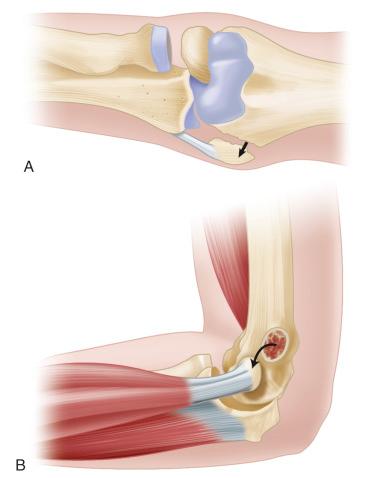
In addition to age, the position of the throwing athlete should be elicited. Pitchers and quarterbacks place the most strain on their arms within their respective sports relative to other position players. In baseball, the likelihood of injury is more prevalent in pitchers and less likely in infielders, catchers, and outfielders, in decreasing order. Athletes who engage in throwing often injure themselves as a result of repetitive overuse rather than direct trauma, making hand dominance an important factor in determining injury.
In addition to this demographic information, the clinician should inquire about pain, which is often the presenting complaint. The onset, character, duration, intensity, location, persistence, and temporal association (e.g., night, day, or with activity) of the pain are important in both diagnosis and formulating a treatment plan. The onset of the pain can be gradual with an overuse injury pattern or more sudden if an avulsion fracture of the medial epicondyle is encountered. The pain may be dull or aching in patients with chronic injuries, or sharp and severe when a more identifiable, acute episode is the culprit.
The duration of the pain is important in determining prognosis. Short episodes of soreness are distinguished from pain that is present before, during, and after throwing, which is a more worrisome finding that could represent chronic overuse and portend a poorer prognosis. The location of the pain can help determine which structures are at risk. The temporal association of the pain is important in determining the most likely site of pathologic findings. Pain during the throwing motion in the late cocking phase typically implies medial overload or instability in a young adult or adolescent patient. Pain at rest or at night could indicate another underlying cause, and a neoplastic process should be ruled out in these instances.
In addition to pain, other symptoms may be present. Decreased ROM, swelling, decrease in velocity or control, and paresthesias or dysesthesias into the upper extremity, particularly the ulnar nerve, can also occur and should be evaluated. Decreased internal rotation of the shoulder has been associated with an increase in humeral retrotorsion seen in overhead throwing athletes, specifically those involved in baseball. Increased humeral retrotorsion has been demonstrated in dominant throwing arms in youth and adult populations when directly compared with nondominant arms. In an adult pitching population, increased retrotorsion was shown to be a preventive adaptation for injury in the shoulder but a contributor for injury to the elbow. Further studies regarding humeral retrotorsion and internal rotation deficits are needed to asses for the true effect on injury patterns in youth and adolescent throwers. After the symptoms have been elicited, a more detailed athletic history should also be obtained. The number of innings pitched, pitch count, type of pitches thrown, pitching rotation schedule, and training schedule can help determine if the athlete is placing his or her arm at risk for injury. Identifying a strain prior to ligament incompetence or growth plate disturbance is important to optimize treatment and prognosis. Associated injuries should also be evaluated, as well as any downstream (wrist/hand) or upstream (shoulder/neck) symptoms that could compromise successful treatment.
The surgical history of the elbow and shoulder should also be evaluated because altered biomechanics of both joints can place increased strain on the elbow during throwing. A thorough medical and family history should also be elicited for all patients with particular attention to any history of osteochondritis, Perthes disease, Kohler disease, and Osgood-Schlatter disease. When patients with any of these diseases participate in sports that increase the articular cartilage demand around the elbow, the likelihood of abnormal epiphyseal development is increased. In addition, a history of delayed skeletal maturation could cause a young child to throw on an age-determined team beyond his or her physiologic tolerance, which could lead to elbow abnormalities.
The physical examination is first focused on the overall demeanor and affect of the young athlete. The examination should proceed in a fairly systematic fashion to decrease the risk of missing associated injuries. A complete examination of the cervical neck for range of motion (ROM), tenderness, and associated provocative tests (e.g., the Spurling test) can help determine cervical spine pathology. Both shoulders should be examined for strength, ROM, and stability. Abnormalities of the scapulothoracic joint, including scapular dyskinesia, should be sought, as should any evidence of internal rotation contracture of the glenohumeral joint, which can contribute to pathologic conditions of the elbow. Both elbows should first be inspected and evaluated for any asymmetry, deformity, or hypertrophy. Throwers often have hypertrophy of the muscles of their dominant arm or an alteration of the carrying angle. ROM of the elbows is assessed in flexion and extension, along with pronation and supination. The medial, lateral, and posterior elbow structures are palpated to elicit any tenderness. Because of the relative subcutaneous position of the osseous structures around the elbow, the medial epicondyle, lateral epicondyle, radial head, olecranon process, and collateral ligaments are readily identified and palpated to specifically identify any areas of discomfort. Patients with medial apophysitis typically demonstrate a flexion contracture greater than 15 degrees with point tenderness over the medial epicondyle.
Palpation of the ulnar nerve is also performed in flexion and extension to evaluate for tenderness and subluxation. With slight flexion, the olecranon fossa can be examined, and gentle pressure can indicate pain over the posteromedial or posterolateral portion of the olecranon fossa. In slight flexion of 25 to 35 degrees, the olecranon is “unlocked” and the ligamentous stability of the elbow can be assessed. The lateral ligaments are assessed with slight varus and internal rotation stress applied to the arm, whereas the medial ligaments are assessed with valgus and external rotation stress applied to the arm. With the elbow flexed 90 degrees and the patient actively supinating, the distal biceps tendon can also be palpated in the antecubital fossa. The insertion of the triceps muscle is also easily identified on the olecranon process, and both of these muscles can be actively tested with flexion/supination and extension, respectively. Comparison is made to the contralateral extremity for any subtle differences that could indicate elbow instability or weakness. The examination concludes with a detailed neurovascular examination of the distal extremity.
Routine radiographs are an essential part of the evaluation of children and adolescents with elbow pain. Anteroposterior (AP), lateral, reverse axial, and comparison views are often obtained to rule out any osseous injury or irregularity of the growth centers. When injury to the ligaments is suspected, stress views can be obtained; however, a normal stress view does not rule out the presence of a significant ligamentous injury. Within the spectrum of little leaguer's elbow, a variety of pathologic conditions can be seen on radiographs. Fragmentation, enlargement, or fracture of the medial epicondyle can sometimes be appreciated. Laterally, osteochondritis dissecans (OCD) can be appreciated as a lucency in the capitellum on oblique radiographs, or in advanced cases, degenerative arthritis and loose bodies may be visualized. Posteriorly, hypertrophy of the ulna may be present, which can impinge in the olecranon fossa of the distal humerus. With repetitive impingement, osteophytes and loose bodies may be visualized in the posterior compartment. Occasionally stress fractures of the ulna or olecranon apophysis can occur, in addition to delayed union at these sites. Classic findings of medial apophysitis include fragmentation and widening of the medial epiphyseal lines relative to the contralateral elbow.
Although most diagnoses can be confirmed with a thorough history, physical examination, and review of radiographs, other imaging modalities have been shown to increase sensitivity and the specificity of diagnosis. Ultrasound has been investigated as a potential imaging modality for evaluating OCD lesions of the capitellum and fragmentation of the medial epicondyle. Bone scans can help determine areas of increased activity in persons with overuse injuries, and computed tomography (CT) scans can help better identify osseous anatomy in instances of fractures and loose bodies with osteophyte formation. Perhaps the most sensitive imaging modality is magnetic resonance imaging (MRI). MRI is helpful in evaluating the soft tissue structures of the elbow (UCL, biceps, triceps, and extensor/flexor tendon attachment sites), the articular cartilage (OCD, loose bodies, and avascular necrosis), and epiphyseal development (apophysis and epiphysis). In addition, in cases of OCD, MRI can help in decision-making with regard to surgical intervention. MRI often demonstrates more positive findings in patients with little leaguer's elbow than do traditional radiographs; however, these findings rarely alter clinical management of these patients.
No hallmark sign accompanies the diagnosis of little leaguer's elbow; often it is the constellation of symptoms, physical signs, and confirmatory findings on radiographs or MRI that leads to the diagnosis. A high index of suspicion is warranted when any child presents with elbow pain and is involved in competitive sports that entail throwing. With prompt diagnosis and treatment, patients can often avoid more serious and long-term sequelae that are associated with this spectrum of injury. Perhaps equally as important is recognizing the variability and normal findings that exist in this population. Hypertrophy of the throwing arm, valgus alignment of the extremity, and flexion contractures are fairly common in this patient population and by themselves rarely warrant treatment in asymptomatic patients.
Treatment of little leaguer's elbow is tailored toward the specific diagnosis that is causing the pain or disability. Because this diagnosis can present along a continuum of injury, from a strain of the medial epicondyle to fracture and incompetence of the UCL, treatment is dependent on a multitude of factors: the injury severity, acuity, level of disability, and age. In patients who do not require acute surgical intervention and who have the capacity to heal, a period of rest is often warranted. In most cases, abstinence from throwing for 4 to 6 weeks results in the cessation of symptoms. The use of ice and nonsteroidal antiinflammatory medications has been shown to be beneficial in the acute stages. Currently no role exists for the use of injected corticosteroids in the management of medial apophysitis. In more severe cases, use of a removable posterior splint with immobilization may be warranted. After 6 weeks of rest, ROM is restored with gentle exercises and strengthening is begun. After 8 weeks, a throwing program is generally begun. Beyond rest, proper instruction on throwing mechanics may reduce the incidence of elbow injuries in these patients. In one investigation, it was found that youth who pitched with better pitching mechanics produced lower humeral internal rotation torque, lower elbow valgus load, and more efficiency during throwing. This study has implications for the prevention of injury through better instruction. With regard to the frequency of pitching and the types of pitches thrown, a prior report demonstrated that the slider was associated with an 86% risk of elbow pain in youth who pitch, and a strong association was found between shoulder and elbow injuries and the number of games played and pitches thrown. Development of the curve ball in youth baseball has been a controversial topic over the past few years. Initially it was thought to place significant stress across the medial elbow leaving athletes prone to injury. Several studies have since refuted this notion and have shown that the forces across the medial elbow are highest in the fastball. Currently the US Baseball Medical & Safety Advisory Committee (USAB-MAC) advises against teaching the curveball before the age of 14, and the American Sports Medicine Institute (ASMI) identifies the curveball and slider as a potential injury risk in inexperienced pitchers. Perhaps the best treatment strategy known is prevention. Preventing excessive pitching in youth sports, enforcing rest days in between outings, discouraging year-round play, and watching for signs of fatigue will likely have a positive impact on the young pitcher's medial elbow. Fatigue has been shown to be a prominent risk factor for injury, and a recent study has shown that a loss of hip to shoulder separation is an early sign in adolescent pitchers. Current guidelines have been developed for pitch counts in youth baseball as well, with the recommendation of pitches based on age. In 2010, Little League Baseball revised the previous guidelines set in 2007 that are in place today. Youths age 7 to 8 are allowed 50 pitches per day, which increases to 75 pitches per day at age 9 to 10. This amount can be increased by intervals of 10 for every 2 years of chronologic age up to age 18. Pitchers 14 years and under are required to rest 1 day for up to 35 pitches thrown with a 1-day rest increase for every 15 pitches thrown thereafter. Ages 15 to 18 require 1 day of rest up to 45 pitches thrown with a 1-day rest increase for every 15 pitches thrown thereafter.
Most patients with medial apophysitis return to sport at their preinjury level of competition with conservative treatment. No large-scale results of conservative management of this entity have been published. Because this diagnosis encompasses such a wide range of pathologic conditions, each distinct clinical entity has a varying prognosis with treatment.
With repetitive injury, after return to sport, the athlete is at risk for the development of growth disturbances around the elbow, persistent pain, avulsion fractures, OCD, and valgus instability after physeal closure.
OCD is a focal lesion of the capitellum that typically occurs in adolescents between 13 and 16 years of age. Theories regarding the origination of this pathologic process vary, with some authors believing that the compressive forces from throwing result in valgus overload and contribute significantly to its development. Other investigations have pointed to the biomechanical mismatch between the capitellum and radial head as a causative mechanism. The etiology of this disease is multifactorial and likely results from microtrauma in the setting of cartilage mismatch and joint susceptibility. Histology from patients who underwent surgery for OCD of the capitellum demonstrated damage to the articular cartilage surface as a result of repetitive stress after a degenerative and reparative process of articular and subchondral fracture. Separation of the fragment occurs on the cartilage surface and may proceed to the subchondral bone in advanced stages.
Panner disease is a clinical entity that is distinct from OCD and is more common in younger patients. This clinical entity is a reversible, degenerative process of the capitellum that begins earlier in childhood, typically between the ages of 7 and 10 years, and involves the secondary ossification center of the capitellum. The hallmark of Panner disease is a process of degeneration followed by regeneration and recalcification. Potential causes of Panner disease have been attributed to endocrine disorders, fat embolism, congenital and hereditary factors, the tenuous blood supply of the capitellum, and repetitive trauma. In the child, the most common cause of lateral elbow pain is Panner disease; however, by adolescence OCD becomes the most common source of this pain. Panner disease has a rather acute onset, with fragmentation of the entire capitellar ossific nucleus.
Patients with OCD most commonly report elbow pain with decreased ability to throw and may localize their symptoms on the lateral side of the elbow. The onset is typically insidious, and as the process progresses, loose bodies may form, which can cause the sensation of a “locking elbow.” Patients report joint stiffness and lack of ROM and may report catching within the joint. Patients with Panner disease may have difficulty describing their symptoms; however, it is usually an aching lateral-sided elbow pain that may be accompanied by swelling. Patients may report an inability to throw a ball or achieve terminal extension of the elbow. Most patients with either condition do not report a traumatic injury or other inciting event. It is important to identify causative mechanisms such as repetitive throwing, endocrine disorders, or family history that could implicate the diagnosis.
In persons with Panner disease, the dominant arm is typically affected. On physical examination, patients may report tenderness over the lateral elbow and capitellum with slight effusion and synovial thickening. ROM is typically affected, with a lack of terminal extension of 20 to 30 degrees. Also noticeable may be a slight lack of pronation or supination with tenderness while attempting this movement.
In patients with OCD, the elbow may not demonstrate significant swelling. Because this clinical entity is commonly associated with little leaguer's elbow, many of the clinical manifestations are similar. Tenderness and laxity of the medial elbow, tenderness over the lateral epicondyle and capitellum, and clicking of the joint may be evident. In most patients, the pain may be difficult to localize because of the spectrum of pathologic conditions that is characteristic in these patients. Patients typically have diminished ROM, and in the setting of loose bodies, they may have acute, sharp pain with certain movements.
In the setting of Panner disease, radiographs in the early stages of the disease demonstrate irregularity of the capitellum with areas of radiolucency and sclerosis, particularly near the physis. After several months, radiographs show enlarged areas of radiolucency with reconstitution of the bony epiphysis. After a period of 1 to 2 years, the epiphysis returns to a normal configuration without flattening. A recent meta-analysis showed no correlation between radiographic parameters and symptoms. In some patients, the adjacent radial head may undergo early maturation compared with the contralateral elbow.
In the setting of OCD, supplemental radiographs such as oblique views or 45-degree flexed views can help better visualize the lesion in suspected cases. The classic finding in pediatric and adolescent OCD is a focal area in the anterolateral capitellum with rarefaction and irregularity of the articular surface. Sclerotic bone may surround the lesion, and loose bodies may be seen when the articular lesion becomes detached. Healing of the lesion can take months to years and is visualized on radiographs as ossification of this radiolucent lesion. CT with or without arthrography may help better delineate the osseous anatomy and articular surface. MRI is the most sensitive test and may detect lesions prior to their appearance on radiographs. In lesions that appear early in the disease process, T1-weighted sequences may detect decreased signal intensity within the lesion, with a normal appearance on T2-weighted sequences. Fat suppressed T2-weighted images are sensitive for detecting OCD lesions on the capitellum but maintain low specificity. Suspicious lesions detected on T2 fat suppressed sequencing can be further correlated on T1. In more advanced cases, high signal intensity and cyst formation around the lesion could indicate impending detachment and loose body formation ( Fig. 134.11 ). More advanced MRI techniques with gadolinium may help define fragment stability and determine staging and prognosis.
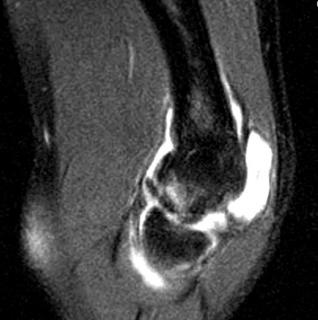
In persons with Panner disease, the key to optimal management is proper diagnosis and recognition. When the clinician recognizes that Panner disease is usually a self-limited condition that disappears by adolescence, proper care and instruction can be provided to both the patient and family. With OCD, several factors determine proper management and treatment. Classification systems of OCD have been devised to help standardize reporting and define treatment. In one of the first classification systems based on AP radiographs, the authors outlined three grades of OCD. In grade I, radiographs demonstrated a translucent cystic shadow in the middle or lateral capitellum. In grade II, a clear zone or split line between the lesion and the adjacent subchondral bone is evident. In grade III, loose bodies are present. This classification was shown to be the most reliable based on CT and radiography. The International Cartilage Repair Society (ICRS) developed the following classification system for defining OCD lesions intraoperatively. ICRS OCD I indicates a stable lesion with a continuous but softened area covered by intact cartilage; ICRS OCD II, a lesion with partial discontinuity that is stable when probed; ICRS OCD III, a lesion with a complete discontinuity that is not yet dislocated; and ICRS OCD IV, an empty defect as well as a defect with a dislocated fragment or a loose fragment lying within the bed. A recent MRI grading system utilizing T2-weighted imaging was proposed that accurately estimates the stability of an OCD lesion compared with intraoperative ICRS grading. Treatment for these lesions is based on stability and is dependent on the ability of the lesion to heal based on the physiologic condition of the elbow ( Table 134.1 ). Based on this classification system, lesions deemed stable heal to completion with nonsurgical management, whereas unstable lesions demonstrate improved results with surgery. As the characterization of capitellar lesions evolves, it will become increasingly important to use this information to predict prognosis and guide treatment. Management of OCD of the elbow is primarily determined by the integrity of the articular cartilage and the stability of the lesion. Unstable lesions are typically managed with surgical intervention, whereas stable lesions demonstrate more intrinsic ability for healing.
| Classification | Capitellar Growth Plate | Range of Motion |
|---|---|---|
| Stable | Open | Normal |
| Unstable | Closed | Restricted |
In general, Panner disease is self-limited and treatment is largely symptomatic. Activity modification, rest, and antiinflammatories have been reported treatment options, with a majority of patients obtaining resolution of symptoms without morbidity.
In the early stages of OCD, treatment is largely nonoperative. Early-grade, stable lesions in patients with open physes are typically managed with a period of rest and cessation of sports participation. The amount of time that the patient refrains from participating in sports is determined by the length of time that symptoms persist. The typical duration is 3 to 6 weeks, followed by a 3- to 6-month period of progressive strengthening and ROM until full participation is achieved. Bracing and the use of nonsteroidal antiinflammatory medication may have a role; however, these treatments are largely supportive and have not been shown to provide tremendous benefit in the literature. In a small series, low-intensity pulsed ultrasound has been shown to shorten the repair period in nonoperatively treated patients.
Surgery for OCD of the elbow is typically reserved for patients who have closed physes, loose bodies, mechanical symptoms, unstable lesions on radiographs or MRI, or who have failed to respond to nonoperative management after 6 months and have a stable lesion. The best surgical procedure for patients with OCD of the elbow is a topic of considerable debate. Surgical options include open or arthroscopic fragment excision (with or without abrasion arthroplasty, drilling, or microfracture), fixation of the unstable or displaced lesion, bone grafting, osteotomy, and osteochondral autograft transplantation (the OAT procedure). Our preference is fixation of these fragments when they are larger and when adequate purchase can be obtained with a 3.0-mm headed cannulated screw. Screw removal is typically necessary 3 months after fixation and healing. When smaller lesions are present, loose body removal and microfracture of the defect is a good surgical option.
The spontaneous healing rates of patients with OCD are varied, and the results in the literature vary from excellent to poor. Mihara et al. found that 25 of 30 early-stage lesions healed at final follow-up, whereas only 1 of 9 late-stage lesions had healed. A significant correlation of healing with open physes compared with closed physes was noted. In another study with longer follow-up, the authors found that more than 50% of the patients with stable lesions treated nonsurgically had mild discomfort at a mean follow-up of 13.6 years. In a different study, 50% of patients treated nonsurgically had persistent elbow symptoms with activities of daily living and also demonstrated radiographic evidence of osteoarthritis at 12.6-year follow-up. These results demonstrate the variability in the outcomes of these patients; however, proper assessment of the stability of the lesion may be the reason for the discrepancy in the data.
For surgical treatment, the results may depend on the technique used, the stage of the lesion, and the length of follow-up of the patients. For open excision of the fragment and débridement, Bauer et al. demonstrated poor results at long-term follow-up, with 40% of patients reporting recurrence of symptoms and loss of elbow extension. These patients all had advanced lesions at the time of surgery. Other studies have demonstrated more encouraging results, with nearly 50% of patients returning to athletics. Short- and midterm results of patients who have undergone arthroscopic débridement and marrow stimulation techniques such as drilling or microfracture are encouraging. A recent meta-analysis in adolescents demonstrated an average return to sport of 87%. In one report, the authors studied three elite gymnasts who underwent arthroscopic débridement and microfracture after failure of an initial trial of nonoperative management. They found full ROM and return to sport in all three patients at 1-year follow-up with hyaline-like cartilage on postoperative MRI. Improvements in Disabilities of the Arm, Shoulder, and Hand scores and symptoms were shown in another study; however, many of the patients demonstrated decreased ability to participate in some sports because of their elbow. Lewine et al., in a more recent study, was able to demonstrate resolution of clinical or radiographical findings in 15 of 21 patients. Seven of these patients were unable to return to their primary sport. In a large retrospective review of fragment fixation versus excision, the authors compared 12 patients who underwent fixation with 55 patients who underwent excision of the unstable lesion. The authors found that fragment fixation performed better than removal, and they recommended bone grafting for higher grade lesions. A recent retrospective review demonstrated healing in 20 of 26 elbows with younger patient age and smaller lesions demonstrating superior results. Several other studies show improved outcomes using fragment fixation with an average return to sport of 68%. Osteotomy is a surgical option in the management of these patients, but it is rarely performed in the United States. In Japan, one study demonstrated good outcomes in baseball pitchers, with six of seven returning to sports, and all seven demonstrated remodeling of the capitellum at 6 months with a mean increase in ROM of 12 degrees. OAT has gained much attention as a treatment option for OCD due to the growing body of evidence over the past decade. Indications include lesions that engage the radial head, larger lesions, higher grade lesions, and laterally based lesions on the capitellum. Recent literature has suggested that larger and more lateral based lesions often perform poorly without aggressive surgical treatment. The short-term results of the OAT procedure in the literature are promising, with more than 90% of patients in most series returning to their preinjury level of function without radiographic degenerative changes. A recent retrospective review of highly competitive adolescent athletes undergoing OAT for unstable capitellar OCD lesions demonstrated a return to play (RTP) of 100% as well as an increase in ROM and reported outcomes. Osteochondral fragment fixation was compared with the OAT procedure demonstrating similar results with regards to ROM, outcome scores, and RTP; however there was a 50% reoperation rate in the fragment fixation group. All patients in the reoperation group had large widespread lesions, leading the authors to conclude that OAT may provide better stability in those lesions.
Patients with Panner disease have relatively few complications. Most patients demonstrate the natural history of the condition with progression to healing. A few may experience worsening symptoms, loose body formation, and progression to an OCD clinical scenario. With OCD, most complications arise from incomplete healing of the lesion. Progression to loose body formation, osteoarthritis, limited ROM, and disability can occur, and athletes should be counseled on the possibility of not returning to their preinjury level of sport. Surgical complications can include infection, stiffness, hardware failure, neurologic injury (affecting the ulnar nerve), and failure to restore normal congruity to the elbow.
Medial epicondyle fractures are common fractures in children and adolescents, accounting for 11% to 20% of all elbow fractures in this patient population. In many instances, this fracture pattern is associated with elbow dislocation; however, in the throwing athlete, this situation is rarely the case, and it is more commonly associated with repetitive overuse and traction on the medial epicondyle from the flexor/pronator mass. Alternatively, a valgus force on the elbow while falling on an outstretched hand can also cause this injury pattern. These fractures most commonly occur in boys, with a peak incidence in age of 11 to 12 years.
Become a Clinical Tree membership for Full access and enjoy Unlimited articles
If you are a member. Log in here